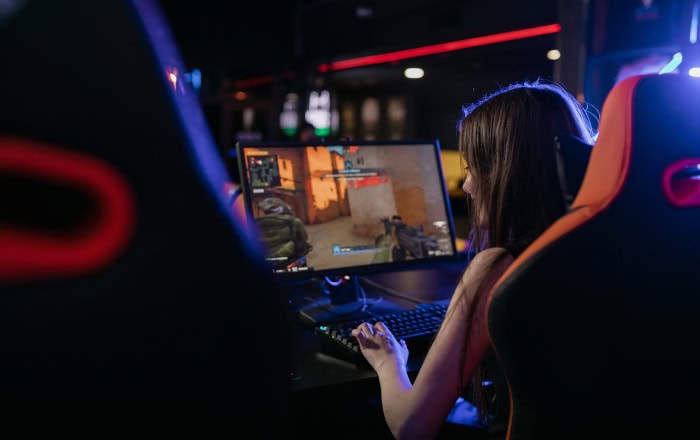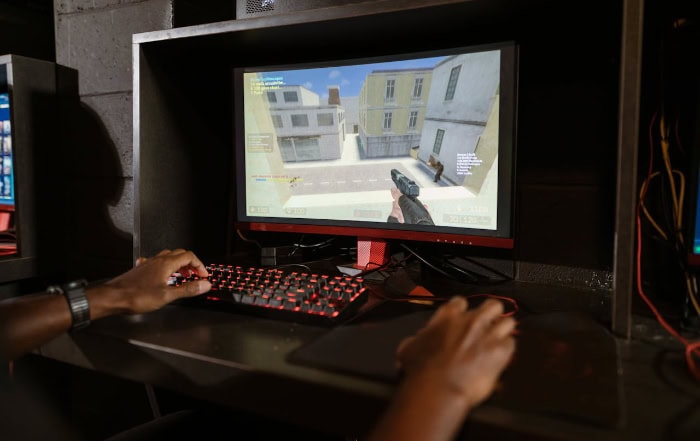How to Lower Ping: Boost Your Gaming Performance Now

Ping: the bane of every online gamer's existence. You're in the middle of an intense match, seconds away from securing victory, when suddenly, your character freezes, and the dreaded “high ping” warning flashes across the screen.
Lag, delays, and disconnects can quickly turn a thrilling gaming session into a frustrating nightmare. But what exactly is ping, and how does it impact your gaming experience? More importantly, what can you do to lower your ping and enjoy smoother, more responsive gameplay?
Ping and Latency Explained
In the world of online gaming, ping and latency are two crucial factors that can make or break your gaming experience. But what exactly are they, and how do they impact your gameplay?
Ping Defined and Its Role in Online Gaming
Ping, measured in milliseconds (ms), refers to the time it takes for a small data packet to travel from your device to the game server and back. In simpler terms, it's the delay between your actions (like clicking a button) and the game server's response.
The lower your ping, the faster the server receives and processes your inputs, resulting in smoother, more responsive gameplay.
The Interplay of Ping, Latency, and Network Quality
Latency, often used interchangeably with ping, encompasses the overall delay in data transmission between your device and the game server. While ping specifically measures the round-trip time of a single data packet, latency takes into account the entire journey of game data, including factors like network congestion, routing efficiency, and server processing time.
A high-quality network with minimal packet loss and stable routing is essential for maintaining low latency and optimal gaming performance.
Ping Ranges and Their Impact on Different Game Genres
The acceptable ping range varies depending on the type of game you're playing. Here's a breakdown of typical ping requirements for popular game genres:
- First-Person Shooters (FPS): FPS games like Counter-Strike, Call of Duty, and Overwatch demand lightning-fast reflexes and precise timing. For competitive play, a ping of 50ms or lower is ideal, while pings up to 100ms are generally tolerable.
- Multiplayer Online Battle Arena (MOBA): MOBAs such as League of Legends and Dota 2 involve strategic decision-making and teamwork. While lower ping is always better, pings up to 100-150ms are playable, as long as they remain consistent throughout the match.
- Role-Playing Games (RPG): Online RPGs like World of Warcraft and Final Fantasy XIV are more forgiving when it comes to ping, as they often emphasize exploration, questing, and character progression over twitch-based combat. Pings up to 200ms are generally acceptable, but lower is still preferable for smoother gameplay.
Tools for Testing and Monitoring Ping
To optimize your gaming experience, it's essential to regularly test and monitor your ping. Most online games have built-in ping displays that show your current latency in real-time.
You can usually find this information in the game's settings or by enabling an in-game overlay.
For more detailed insights, you can use third-party software like PingPlotter or WinMTR to track your ping over time, identify network issues, and pinpoint potential bottlenecks. These tools provide graphs and reports that help you analyze your connection stability and detect patterns in ping spikes or packet loss.
Network Connection Optimization

Now that you have a solid understanding of ping and latency, it's time to focus on optimizing your network connection to minimize ping and enhance your gaming performance.
Wired vs. Wireless Ethernet Cable Advantages
When it comes to online gaming, a wired connection using an Ethernet cable (Cat 6 or higher) is always preferable to a wireless connection. Wired connections offer several advantages:
- Stability: Ethernet cables provide a more stable and reliable connection compared to Wi-Fi, which can be subject to interference, signal degradation, and dropouts.
- Lower Latency: Wired connections typically have lower latency than wireless ones, as data packets travel directly through the cable without the need for wireless signal processing.
- Faster Speeds: Ethernet cables, especially Cat 6 or higher, can support faster data transfer speeds than most wireless connections, ensuring smooth and responsive gameplay.
Router Placement and Configuration
To get the most out of your gaming setup, it's crucial to position your router strategically and configure its settings for peak performance. Here are some tips:
- Router Placement: Place your router in a central location, away from obstructions and interference sources like walls, metal objects, and electronic devices. Ensure your gaming device has a clear line of sight to the router for the best signal strength.
- Quality of Service (QoS) Settings: Configure your router's QoS settings to prioritize gaming traffic over other network activities. This ensures that your gaming data packets receive preferential treatment, reducing latency and minimizing the impact of network congestion.
- Firmware Updates and Channel Optimization: Regularly update your router's firmware to benefit from performance improvements, bug fixes, and security enhancements. Additionally, experiment with different Wi-Fi channels to find the least congested one in your area, minimizing interference from neighboring networks.
Network Congestion and Bandwidth Management
Network congestion and bandwidth-hogging applications can significantly impact your gaming experience. To mitigate these issues:
- Identify Bandwidth-Hogging Applications: Use network monitoring tools to identify applications and devices that consume excessive bandwidth. Common culprits include streaming services, file-sharing programs, and background updates.
- Limit Bandwidth Usage: Once identified, limit or pause bandwidth-intensive activities during gaming sessions. Close unnecessary applications, disable automatic updates, and schedule large downloads outside of gaming hours.
Internet Plan and Hardware Upgrades
If you're still experiencing high ping despite optimizing your network setup, consider upgrading your internet plan and hardware:
- Internet Speed Requirements: For online gaming, a minimum download speed of 3 Mbps and an upload speed of 1 Mbps are recommended. However, for the best experience, aim for download speeds of 25 Mbps or higher, especially if you share your network with others.
- Gaming-Focused Router and Modem: Invest in a gaming-focused router and modem designed to prioritize gaming traffic, reduce latency, and offer advanced features like built-in VPN support and customizable QoS settings. These specialized devices can significantly improve your gaming network performance.
In-Game Optimizations

While optimizing your network connection is crucial for lowering ping, there are also several in-game settings and techniques you can employ to further reduce latency and improve your gaming performance.
Graphics Settings Adjustments
One of the most effective ways to reduce in-game lag is by optimizing your graphics settings. Here's how:
- Lower Resolution and Visual Quality: Reducing your game's resolution and lowering demanding visual settings like texture quality, shadow detail, and anti-aliasing can significantly improve performance and minimize lag. Find the right balance between visual fidelity and smooth gameplay.
- Utilize Performance Modes and Presets: Many games offer built-in performance modes or presets that automatically adjust graphics settings for optimal performance. Experiment with these options to find the best configuration for your system.
Background Process and Application Management
Background processes and applications can consume valuable system resources, leading to increased latency and reduced gaming performance. To mitigate this:
- Close Unnecessary Programs: Before launching your game, close any unnecessary programs and browser tabs that may be running in the background. This frees up system resources for your game, reducing the likelihood of lag spikes.
- Disable Automatic Updates and Notifications: Automatic updates and notifications from applications can cause sudden performance drops and network congestion. Disable these features during gaming sessions to maintain a stable and uninterrupted experience.
Game-Specific Network Settings and Tools
Many online games offer advanced network settings and tools that allow you to fine-tune your connection for optimal performance. Take advantage of these features to minimize latency:
- Network Buffering and Packet Size Adjustments: Some games provide options to adjust network buffering and packet size. Experiment with these settings to find the optimal configuration for your connection, as they can impact latency and overall responsiveness.
- In-Game Ping Displays and Network Graphs: Utilize in-game ping displays and network graphs to monitor your latency in real-time. These tools help you identify sudden ping spikes, packet loss, or other network anomalies, allowing you to take corrective action or troubleshoot issues promptly.
Server Selection and Geographical Location Optimization

Selecting the right server and optimizing your geographical location can have a significant impact on your ping and overall gaming experience.
Server Proximity's Impact on Ping and Latency
The physical distance between your device and the game server plays a crucial role in determining your ping and latency. Here's what you need to know:
- Data Transmission Speed and Distance: The further the distance between your device and the game server, the longer it takes for data packets to travel back and forth, resulting in higher ping and latency. This is because data transmission is limited by the speed of light and the quality of network infrastructure.
- Real-World Ping Comparisons: To illustrate the impact of server proximity, consider the following examples. If you're located in New York and connect to a server in Los Angeles, you might experience a ping of around 80-120ms. However, if you connect to a server in London, your ping could be 150-200ms or higher, depending on network conditions.
Selecting the Optimal Server Region for Your Location
To minimize ping and latency, it's essential to choose a server region that is geographically close to your location. Here's how:
- Server Browser Tools and Filters: Most online games provide server browser tools that allow you to filter and sort servers based on ping, location, and other criteria. Use these tools to find the closest available servers with the lowest ping.
- Experimenting with Different Server Regions: If you're located between multiple server regions, it's worth experimenting with each one to determine which provides the best ping and overall performance. For example, if you're in the middle of the United States, try connecting to servers in both the East and West regions to see which offers the lowest latency.
Navigating Peak Hours and High-Traffic Periods
Peak gaming hours and high-traffic periods can significantly impact server performance and your ping. To mitigate these issues:
- Identifying Peak Gaming Times: Peak gaming times vary by region, but they typically occur during evenings and weekends. During these periods, servers are more crowded, leading to increased network congestion and potentially higher ping.
- Strategies for Finding Less Crowded Servers: To avoid the negative effects of peak hours, consider playing during off-peak times or searching for less popular servers. You can also use server browser filters to find servers with lower player counts or those located in regions with different peak gaming hours.
Gaming VPNs for Improved Routing and Reduced Latency
Gaming VPNs (Virtual Private Networks) can help optimize your network routing and potentially reduce latency. Here's how they work:
- Optimizing Network Paths: Gaming VPNs can route your traffic through more efficient network paths, bypassing congested or suboptimal routes. By connecting to a VPN server closer to the game server, you may experience reduced ping and improved connection stability.
- Circumventing ISP Throttling: Some ISPs (Internet Service Providers) may throttle gaming traffic during peak hours to manage network congestion. Gaming VPNs can help circumvent this throttling by encrypting your traffic and making it more difficult for ISPs to identify and limit gaming data.
When choosing a gaming VPN, opt for reputable, gaming-focused services like Mudfish or ExitLag. These VPNs offer features specifically designed to optimize gaming performance, such as intelligent routing algorithms and low-latency server networks.
Troubleshooting High Ping Issues
Despite your best efforts to optimize your network and in-game settings, you may still encounter high ping issues from time to time.
Common Causes of High Ping
Several factors can contribute to high ping, including:
- Network Congestion: Heavy network traffic, particularly during peak hours, can lead to increased ping and latency. This congestion can occur on your local network or on the broader internet infrastructure.
- Outdated Drivers and Firmware: Outdated network adapter drivers, router firmware, or game client software can cause compatibility issues and degrade network performance, resulting in higher ping.
- Background Updates and Malware: Automatic updates, background processes, and malware can consume network bandwidth and system resources, causing ping spikes and latency issues.
- ISP Throttling and Routing Issues: Some ISPs may throttle gaming traffic or have suboptimal routing configurations, leading to increased ping and packet loss.
Step-by-Step Troubleshooting Process
To diagnose and fix high ping issues, follow these steps:
- Perform a Clean Boot: Eliminate software conflicts by performing a clean boot of your system. This process involves disabling all non-essential startup programs and services, helping you identify if any background processes are causing ping spikes.
- Update Drivers and Firmware: Ensure your network adapter drivers, router firmware, and game client software are up to date. Visit the manufacturer's website to download and install the latest versions.
- Analyze Network Routes: Use command prompt tools like “tracert” and “pathping” to analyze the network route between your device and the game server. These tools can help identify any bottlenecks, high-latency hops, or packet loss along the way.
Collaborating with Your ISP
If you've exhausted all troubleshooting steps and still experience high ping, it's time to involve your ISP. Here's what you can do:
- Contact Customer Support: Reach out to your ISP's customer support and explain the issue you're facing. Request line tests and repairs to ensure there are no physical problems with your connection.
- Document Ping Spikes and Disconnects: Keep a log of ping spikes, disconnects, and other network issues you encounter. Note the date, time, and duration of each occurrence. This documentation can help your ISP identify patterns and pinpoint potential causes.
Managing Expectations and Understanding Limitations
While it's essential to strive for the lowest possible ping, it's equally important to manage expectations and understand the inherent limitations that can affect latency:
- Distance and Infrastructure: The physical distance between your location and the game server, as well as the quality of the network infrastructure along the route, can significantly impact ping. Even with optimal settings, you may experience higher latency if you're geographically far from the server or if there are infrastructure limitations.
- Acceptable Ping Ranges: While extremely low pings (<20ms) are ideal, they may not always be achievable due to factors beyond your control. In most cases, pings between 50-100ms are considered acceptable for online gaming, depending on the game genre and your personal tolerance for latency.

